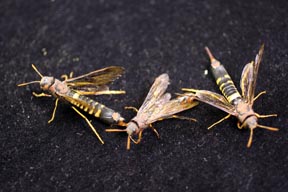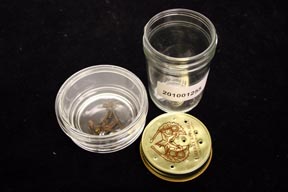Horntails emerging from firewood
Editor’s note: This article is from the archives of the MSU Crop Advisory Team Alerts. Check the label of any pesticide referenced to ensure your use is included.
A very excited client brought in three nice specimens of pigeon tremexes or common horntails, Tremex columba (Hymenoptera: Siricidae) this past week. Like most clients who bring in live specimens, this concerned and kind man had punched several holes in the lid of the jar containing his specimens to allow them to breathe. Whether 8 or 80, amateur bug collectors who bring me their bugs nearly always show up here with holes punched in lid of their jar. It’s just adorable.
Horntails are somewhat odd-looking insects that are related to sawflies, bees and wasps. The larvae are woodborers in deciduous trees that are dead or in a state of decline. Horntail larvae can be found in maple, elm, oak, hickory, sycamore, beech, apple and pear trees. Females prefer to lay their eggs in unhealthy and dying trees, and therefore, they are normally considered a symptom of an unhealthy tree or branch, not the cause of the problem. These wood wasps can be found pretty much throughout the summer. Females drill holes into suitable wood with their ovipositor and lay between two and seven eggs in the drilled hole. Like other wood wasps (Siricidae), the female pigeon tremex inoculates the wood with a wood-rotting fungus when she lays her eggs. Eggs usually hatch in three to four weeks, and larvae feed on the fungus-softened wood as they bore out long round tunnels that meander through both the sapwood and heartwood. The larvae must eat the fungus in order to develop, without it they quickly die. Two years are required in Michigan for these interesting insects to complete a life cycle.



 Print
Print Email
Email






